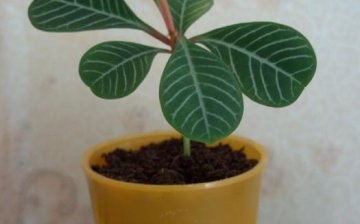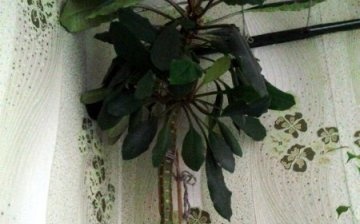Euphorbia white-streaked: a brief care guide
This indoor flower, the white-tipped euphorbia, comes from the island of Madagascar, which determines both its appearance and its care preferences. He was nicknamed white-streaked for its whitish-silvery streaks on dark green leaves.
Appearance of white-veined milkweed
Its structure resembles a palm tree: dense oval pointed leaves remain only at the top, and those that grow on the trunk fall off as it lengthens. Thus, the upper leaves of the milkweed are always young.
The trunk is rounded from below, lignified, to the middle it has a five-ribbed structure, and then somewhat thickens. There are many spikes on the ribs, no more than 4 mm.
Favorable conditions for white-veined milkweed are:
- Temperature range from 18 to 24 degrees
- Abundant watering in summer and moderate in winter
- Not overdried soil
- Monthly feeding
- Annual transfer to a larger pot (wide, not deep)
- Correctly selected soil (leaf and turf soil, coarse sand, peat, red brick chips, pieces of charcoal, humus). Both the composition and the concentration of the ingredients are important.
Possible troubles associated with the cultivation of milkweed, and ways to eliminate them
- Leaves sank and fall: the substrate is allowed to dry out.
- Roots rot: over-watering.
- Loss of most leaves in winter: temporary, they will grow back in spring.
- Grows poorly in a shaded area and in the open sun: provide access to indirect sunlight, exclude shade.
- Burns, burning, inflammation resulting from contact with the poisonous juice of this plant on the skin, especially mucous membranes: rinse abundantly with cold water and consult a doctor. This important nuance should always be remembered, especially if there are children in the house. Do not put white-spiked spurge in the nursery!






